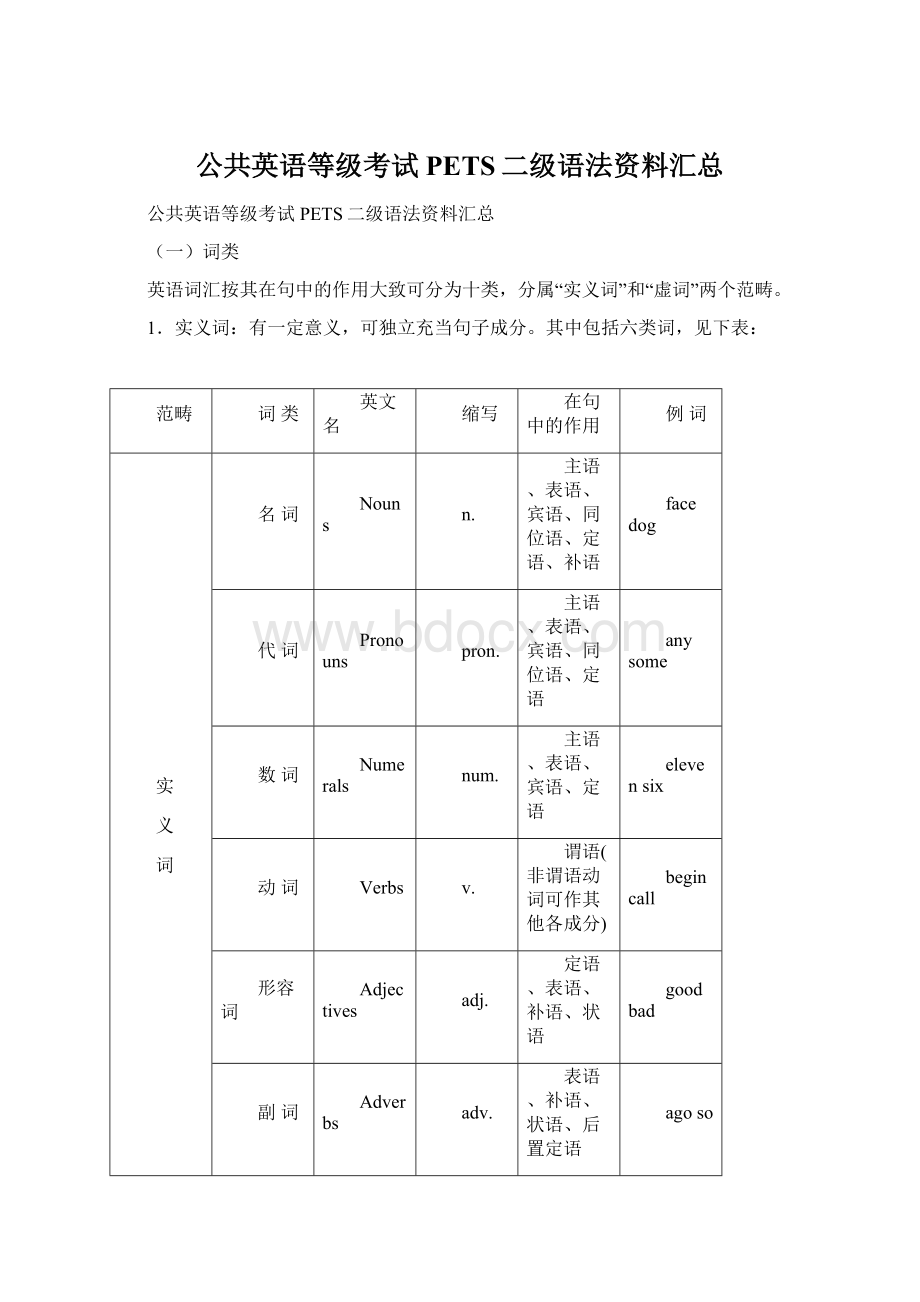公共英语等级考试PETS二级语法资料汇总.docx
《公共英语等级考试PETS二级语法资料汇总.docx》由会员分享,可在线阅读,更多相关《公共英语等级考试PETS二级语法资料汇总.docx(41页珍藏版)》请在冰豆网上搜索。

公共英语等级考试PETS二级语法资料汇总
公共英语等级考试PETS二级语法资料汇总
(一)词类
英语词汇按其在句中的作用大致可分为十类,分属“实义词”和“虚词”两个范畴。
1.实义词:
有一定意义,可独立充当句子成分。
其中包括六类词,见下表:
范畴
词类
英文名
缩写
在句中的作用
例词
实
义
词
名词
Nouns
n.
主语、表语、宾语、同位语、定语、补语
facedog
代词
Pronouns
pron.
主语、表语、宾语、同位语、定语
anysome
数词
Numerals
num.
主语、表语、宾语、定语
elevensix
动词
Verbs
v.
谓语(非谓语动词可作其他各成分)
begincall
形容词
Adjectives
adj.
定语、表语、补语、状语
goodbad
副词
Adverbs
adv.
表语、补语、状语、后置定语
agoso
2.虚词:
不在句中独立充当成分,用来说明词与词,句与句的关系或句子语气等,其中包括四类,见下表:
范畴
词类
英文句
缩写
例词
虚
词
冠词
Articles
art.
aanthe
介词
Prepositions
prep.
atacrossalongto
连词
Conjunctions
conj.
andbutbecausewhich
感叹词
Interjections
interj.
wellhellooh
(二)名词
1.名词的概念和种类:
表示人或事物名称的词叫名词。
有以下四种:
类别
意义
例词
专有名词
表示人、地方、机构的专有名称
BeijingtheGreatWall
普通名词
可数
个体名词
表示某类人或物中的个体名称
studentteacher
集体名词
表示一群人或物的集合体
familygovernment
不可数
物质名词
表示无法分为个体的实物
waterair
抽象名词
表动作、状态、品质、感情等抽象概念
beautyyouth
2.可数名词:
个体名词和集体名词可以用数目来计算称为可数名词;其单数形式前要有a/an/the或数词one或某些限定词来修饰。
两个以上的,单词要变成复数。
变化规则如下:
序号
构成方法
例词
1.
一般在词尾加-s
student—students
2.
以ce,se,ze,(d)ge结尾的词加-s
page—pages
3.
在[s,z,F,V,tF]后加-es
watch—watches
4.
以辅音字母加o结尾的指人或食物的词加-es
hero—heroes
5.
以辅音字母加o结尾的外来词或缩写词只加-s
piano—pianos
6.
元音字母加o结尾的词加-s
radio—radios
7.
辅音字母加y结尾的改y为i再加-es
factory—factories
8.
词尾为f或fe的改f或fe为v,再加-es
knife—knives
9.
有些以f或fe结尾的只加-s
belief—beliefs
10.
有些单、复数同形
sheepfishdeerChineseJapanese
3.不可数名词:
物质名词和抽象名词一般无法用数目来计算,没有复数形式,也不直接用数词或a/an,one等来修饰。
要表示一定数量的“不可数名词”时,用表数量的名词短语来修饰。
如:
apieceofbreadthreepiecesofnews
adropofwater
4.名词的所有格:
表示名词的“所有”或“从属”关系的形式,主要有“’s”和“of”两种形式。
情况
表示法
例词或例句
名
词
的
所
有
格
有
生
命
的
名
词
一般单数名词情况
词尾加-’s
myfather’shat
以“s”结尾的复数名词
只加-’
thestudents’readingroom
不以“s”结尾的复数名词
加-’s
thechildren’spalace
人名以“s”结尾
加-’或-’s
Engels’/Engels’sworks
以〔F,V,z、tF,dV〕结尾的
加-’s(读〔iz〕)
Marx’schildhood
并列名词各自所有
各名词后加-’s
Lily’sandMary’srooms
并列名词共有
最后的名词后加-’s
LiLyandMary’sroom
无生命的词
时间
词尾加-’(s)
today’snewspaper
距离
词尾加-’(s)
threehours’ ride
地点
词尾加-’(s)
China’spopulation
金钱价值
词尾加-’(s)
2,000dollars’worth
量度
词尾加-’(s)
fiftypounds’weight
其他
用of所有格注意词序
thewindowsoftheroom
三)代词
1.代词分类表:
英语中代词有九类,用来指代名词或上、下文中的词,词组或句子。
序
号
数
人
种称
类
单数
复数
一
二
三
一
二
三
1
人称
代词
主格
I
you
he
she
it
we
you
they
宾格
me
you
him
her
it
us
you
them
2
物主
代词
形容
词性
my
your
his
her
its
our
your
their
名词性
mine
yours
his
hers
its
ours
yours
theirs
3
反身代词
myself
yourself
himself
herself
itself
ourselves
yourselves
themselves
4
指示代词
thisthat
thesethose
5
不定代词
指代人
somebody,someone,anybody,anyone,nobody,noone,everybody,everyone
事物
something,anything,nothing,everything
指代人或物事
one,another,each,every,much,either,neither,little,alittle
ones,others,theothers,both,few,afew,many,several
some,any,no,all,other,theother,none,alot(of),such
6
相互代词
eachother,oneanother,eachother’s,oneanother’s
7
疑问代词
who(ever),whom(ever),whose(ever),which(ever),what(ever)
8
连接代词
who(ever),whom(ever),whose(ever),which(ever),what(ever)
9
关系代词
who,whom,whose,which,that,as
2.人称代词用法表:
序号
作用
用法说明
例句
1
作主语
用主格
Doesheenjoylisteningtomusic?
2
作表语
指主语用主格
Wasitshewhosawthewhitecat?
指宾语用宾格
Ibelievethewritertobehim.
3
作宾语
用宾格
Thesebooksbelongtothem.
注意:
(1)代词并列时,排列顺序为“二,三,一”人称,如:
“you,heandI”;“himandme”。
(2)人称代词常在名词后,但“you”在名词前,如:
“you,TomandI”。
(3)其他种类代词在“人称代词”后,如:
“heandsomeothers”。
(4)口语中,宾格作表语,如:
“It’sme.”。
3.物主代词:
分类
句法功能
例句
形容词性物主代词
作定语
Thisismypen.
名词性物主代词
作主语、表语、宾语
Thisbikeishers.
注意:
名词性物主代词可用于双重所有格中:
Sheisafriendofmine.
4.反身代词:
序号
在句中充当的成分
例句
1
宾语
位于动词后
Shecoulddressherselfwhenshewassix.
位于介词后
Takecareofyourselves.
“宾语+and”后
SheinvitedMikeandmyselftotheparty.
2
表语
Hedoesn’tseemhimselftoday.
3
同
位
语
主语同位语
Hehimselfhadtodoit/Hehadtodoithimself.
宾语同位语
Youcanaskthepresidenthimself.
4
并
列
主
语
and之后
(Both)Maryandmyselfwillgo.
or之后
(Either)Maryoryourselfwillgo.
nor之后
(Neither)Mikenoryourselfhaveanythingtodowithit.
注意:
(1)反身代词不单独作主语。
(2)oneself也是一个反身代词,用法与上面相同。
Oneshouldnotliveforoneselfalone.
5.指示代词:
“this,that,these,those”,可作名词用也可作形容词用。
见下表:
在句中的成分
例句
1
作
名
词
用
作主语
ThisisSmith.
2
作宾语
Ilikethis.
3
作表语
Hisideaisthis.
4
作形容词用
作定语
Thisway,please.
6.不定代词:
序
号
分
类
功
能
用法
不定代词
例词或例句
说明
1
作
形
容
词
定语
接可数单数
every“每个的”,只作定语
everybody
指三者或三者以上的“每个的”。
接可数复数
other
otherboys
接三类名词
no
nopeople
no=nota/any
2
作
名
词
主语、表语、宾语
代单数(人)
someone,somebody
anyone,anybody
everyone,everybody
noone,nobody
SomeoneiswaitingforJack.
Iseveryonehere?
Isthereanybodyout?
someone,somebody用肯定句中或表建议等的疑问句中;
anyone,anybody用于否定条件句或疑问句中。
代单数(物)
something,anything
nothing,everything
Somethingiswrongwithmybike.
something用于肯定句或表建议等的句子里;anything用于否定句或疑问句中。
代复数
(人/物)
others,theothers
Shelikestohelpothers.
Wherearetheothers?
theothers其余的人/物。
none
Noneofusisafraid.
指三者或三者以上当中“没一个”。
3
既可作名词又可作形容词
主语、定语、表语、宾语
不可数
little,alittle,much
There’slittletimeleft.
little“几乎没有”,表否定。
可数复数
few,afew,many,several,both
Bothmysistersaregood.
few“几乎没有”表否定;both只用于两者“两者都”。
可数单数
oneeach(二者或三者以上的“每一”)
another,either,neither
Eachstudenthasapencil.
either二者之中任一个;neither二者之中没一个。
接/代三类名词
all,some,any,such,theother
Hehastwosons.Oneisadoctor.Theother(one)isateacher.
some用于肯定句或表建议的句中;any用于否定、疑问句或条件句中。
可数复数或不可数
lotsof,alotof,alot
Hehaslotsof/alotoffriends.
Hehasalottosay.
注意:
(1)both(二者都)和all(三者或以上都)可以作同位语,位于助动词,系动词或情态动词后,行为动词之前。
Theboysareallintheclassroom.
Both(of)mybrotherslikesports.
(2)everyother+可数名词单数:
指“每隔一…”。
Theygotoplaybasketballeveryotherday.
(3)no/any/every/some与one/body构成的复合词指人,不用于of前。
(4)all/both/every及其复合词与否定词连用时,表部分否定。
相应的全否定为none/neither/noone/nobody/nothing等。
Notallofusareteachers=Allofusarenotteachers.
Noneofusarestudents.
(5)“another+数词+名词复数”表示“再来(数词)…”。
Anothertwocoffees,please.
(6)theother+单数可数名词或不可数名词或复数可数名词表示“其余的/所有剩下的…”。
Theotherboysareplayingontheplayground.
theother后不接任何词时,指“二者中的另一个。
”
Ihavetwoskirts.Oneisred.Theotherisblueandwhitestripes.
7.疑问代词:
用来构成特殊疑问句。
在句中可作主语、宾语、表语、定语、补语等。
在句中成分
例句
主语
Whodidit?
宾语
Whatareyoudoing?
定语
Whosebikeisit?
补语
WhatdoyoucallitinJapanese?
表语
Whoseisthisbook?
(四)数词
1.数词分类:
分类
在句中充当的成分
例词
基数词
主语、表语、宾语、定语、同位语
one,eleven,fifty
序数词
主语、表语、宾语、定语、同位语、状语
second,eighth,fortieth
2.基数词的构成及用法:
类型
构成方法
例词
1-12
单独的词
one,two,three,four,five,six,seven,eight,nine,ten,eleven,twelve
13-19
在3-9的词尾加上“-teen”
thirteen,fourteen,fifteen,sixteen,seventeen,eighteen,nineteen
20,30,40-90
以“-ty”结尾
twenty,thirty,forty,fifty,sixty,seventy,eighty,ninety
100,1000,1000,000,
1000000000,
百,千,百万,十亿都有具体量词
one/ahundred,one/athousand,
one/amillion,one/abillion
21-99
“几十”和“个位”之间用连字符“-”
twenty-three,forty-eight
101-999
“百位”后“十位”前加“and”
826:
eighthundredandtwenty-six
1,000以上
先从右向左每三位数加一逗号,从右向左第一个逗号为thousand,第二个为million,第三个为billion,然后每三位为一单位从左向右读。
1,234,567,892:
onebillion,twohundredthirty-fourmillion,fivehundredsixty-seventhousandeighthundredandninety-two
3.序数词的构成:
类型
构成特点
例词及缩写式
one,two,three
单独记忆
first(1st),second(2nd),third(3rd)
four~nineteen
在基数词尾加-th
fifth(5th),ninth(9th),twelfth(12th)
-ty结尾的词
把y→ie,在基数词尾加-th
twentieth(20th),fiftieth(50th),fortieth(40th)
以1~9结尾的多位数
变个位数为序数词即可
twenty-first(21st),ninety-ninth(99th)
hundred,thousand,million,billion
在基数词尾加-th即可
hundredth(100th)thousandth(1,000th)millionth
(1,000,000th)billionth(1,000,000,000th)
4.序数词的用法:
序号
用法特点
举例
1
前面要加the
He’salwaysthefirsttogettomeeting-room.
2
前面用a/an表“又一,再一”
He’dbettertryafourthtime.
五)介词
1.介词的概念及分类:
介词是一种虚词,不能单独在句中充当成分,要与宾语一起构成介词短语才可在句中充当成分。
介词按形式分为简单介词、复合介词、短语介词、特殊介词和双重介词。
分类
例词
按
形
式
分
简单介词
at,about,above,after,as,but,by,down,during,except,for,from,in,like,near,off,of,on,opposite,over,past,round,since,through,till,to,under,until,up,besides,between,beyond,with,across,against,along,among,around,before,behind,below,beside
复合介词
inside,outside,onto,into,toward(s),upon,within,without
短语介词
alongwith,togetherwith,accordingto,aheadof,asfor,asto,becauseof,dueto,exceptfor,owingto,outof,upto,bymeansof,bythesideof,bywayof,infrontof,inspiteof,asfaras
特殊介词
concluding,regarding,considering,save
双重介词
untilafter,untilbefore,Saturday,except,onduty
按
功
能
分
空间(地方、位置、方向、范围、界限、包括、排除)
about,above,across,after,against,along,among,(a)round,at,before,behind,with,below,beneath,beside,besides,between,upon,save,beyond,but,by,concerning,down,on,outof,outside,over,past,through,throughout,towards,under,up
时间
after,before,as,between,by,during,for,from,in,on,over,past,till,until,upto,within,through,throughout
原因理由根源(目的,内容等)
about,accordingto,as,becauseof,dueto,owingto,onacountof,from,of,on,with,regarding,concerning,considering,through,by,under,for
2.容易混淆的介词:
区别
讲解
例句
表
时
间
的
介
词
at,on,in
at表示“在几点几分”(单位最小);on表示“在具体的某一天或某天上午(下午晚上等)”;
in表示“在几天、周、月、年”。
Igetupatsixo’clock.
Ithappenedonaspringmorning.
Therearesevendaysinaweek.
inthemorning/evening/afternoon;atnoon/night/dawn/sunrise/sunset/lunch/dinner/supper,et